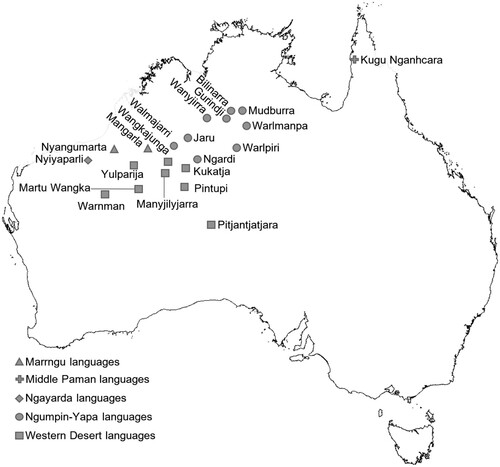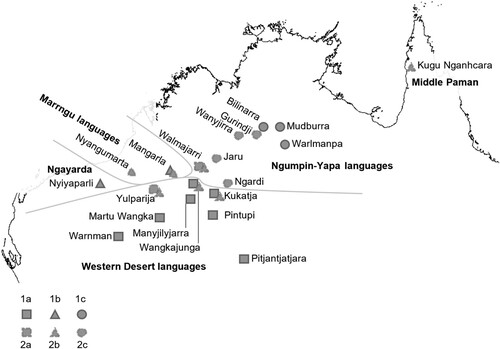Figures & data
Figure 1. Approximate locations of the Pama-Nyungan languages surveyed in this paper which can cross-reference at least one type of nominal expression marked with local case. (e.g. locative, allative, elative, etc.)

Table 1. Grammatical relations of Ngardi (Ennever, Citation2021, p. 502).
Table 2. Western Mudburra bound pronominal paradigm (Osgarby, Citation2018, p. 122).
Table 3. Possibility for cross-referencing of local case-marked NPs in surveyed languages (a dash indicates there is no distinct case form).
Table 4. Sample verbs from the Warburton Ranges variety of Western Desert (data adapted from Koch, Citation2014, p. 155).
Table 5. Pattern types of local case cross-referencing in relation to other non-subject series.
Table 6. Non-subject bound pronouns in Kukatja (Valiquette, Citation1993, pp. 453–454).
Table 7. Non-subject bound pronouns in Nyangumarta (Marrngu) (Sharp, Citation2004, p. 91). Forms with ‘=’ are phonologically bound to a verbal host, and forms with ‘#’ are phonologically independent pronouns, but still syntactically bound to the post-verbal position.
Table 8. Non-subject bound pronouns in Mudburra (Osgarby, Citation2018, p. 118)a.
Table 9. Non-subject bound pronouns in Yulparija (Wangka Maya Pilbara Aboriginal Language Centre, Citation2008).
Table 10. Non-subject bound pronouns in Ngardi (Ennever, Citation2021, pp. 297–298).
Table 11. Two series of bound pronouns for locational case cross-referencing in Wangkajunga (Jones, Citation2011, pp. 140–141).
Table 12. Non-subject bound pronouns in Walmajarri (Hudson, Citation1978, pp. 60–62).
Table 13. Surveyed languages categorized by pattern type.
Table 14. Surveyed languages categorized into genetic subgroup with corresponding pattern type.
Figure 2. Surveyed languages categorized by their cross-referencing pattern(s). Languages which do not cross-reference locationals are excluded from this figure

Table 15. Comparison of object/dative and locational reflexive pronominal forms.
Data availability statement
The data that support the findings of this study are either openly available from the referenced resources in the public domain, or available from the corresponding author, TE, upon reasonable request.
